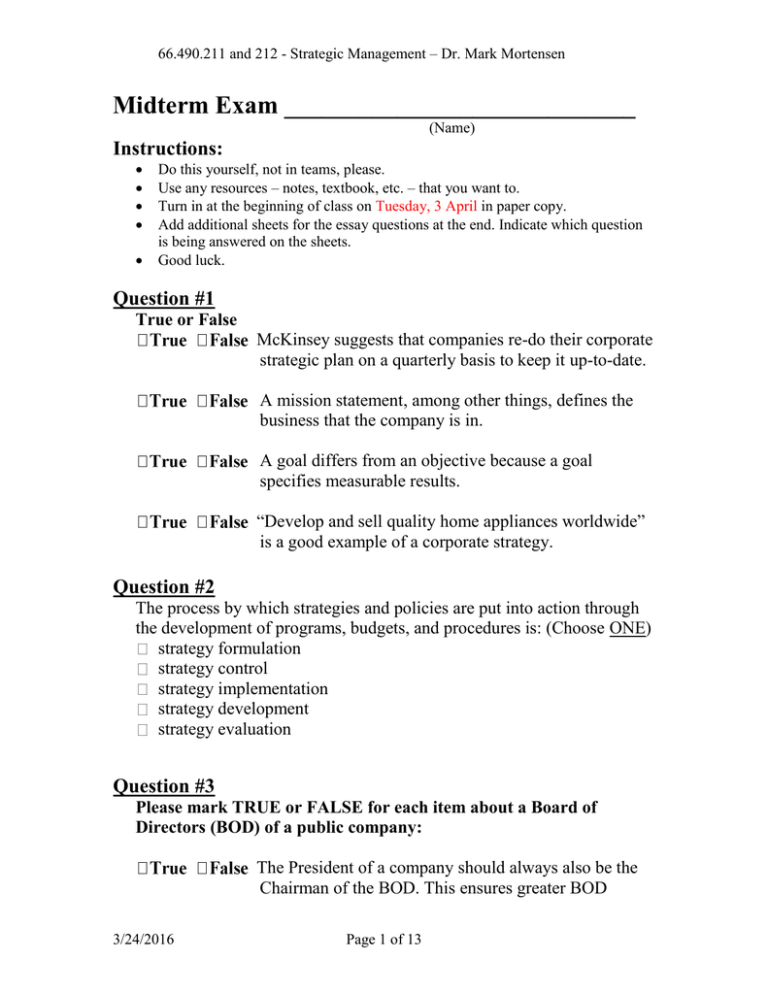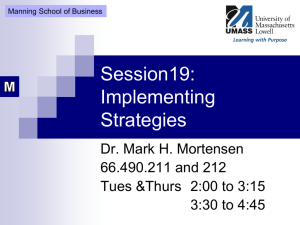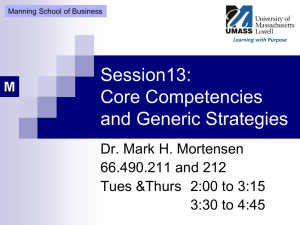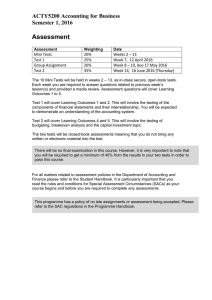Quiz-2-midterm - take home version - Mark
advertisement

66.490.211 and 212 - Strategic Management – Dr. Mark Mortensen Midterm Exam ____________________________ (Name) Instructions: Do this yourself, not in teams, please. Use any resources – notes, textbook, etc. – that you want to. Turn in at the beginning of class on Tuesday, 3 April in paper copy. Add additional sheets for the essay questions at the end. Indicate which question is being answered on the sheets. Good luck. Question #1 True or False McKinsey suggests that companies re-do their corporate strategic plan on a quarterly basis to keep it up-to-date. A mission statement, among other things, defines the business that the company is in. A goal differs from an objective because a goal specifies measurable results. “Develop and sell quality home appliances worldwide” is a good example of a corporate strategy. Question #2 The process by which strategies and policies are put into action through the development of programs, budgets, and procedures is: (Choose ONE) strategy formulation strategy control strategy implementation strategy development strategy evaluation Question #3 Please mark TRUE or FALSE for each item about a Board of Directors (BOD) of a public company: The President of a company should always also be the Chairman of the BOD. This ensures greater BOD 3/24/2016 Page 1 of 13 66.490.211 and 212 - Strategic Management – Dr. Mark Mortensen knowledge of the strategy and execution plans of the company. The BOD must agree to the executive compensation for the President and members of the senior staff. One of the BOD’s main jobs is caring for shareholder interests. No employee of the company can, by law, be a member of its BOD, except for the President and VicePresidents. Question #4 Which of the following are current trends in corporate governance? (Choose ALL that apply) Boards are getting more involved in not only reviewing and evaluating company strategy, but also in shaping it. Most companies are actively resisting class action suits by shareholders, ensuring that the company’s strategy is controlled by the professional managers. Most Boards are getting smaller, primarily because of the reduction of insiders. Shareholders are demanding that directors and top managers own more than just token stock in the companies so that they take a longerterm view of the company. Question #5 Ethics: True or False Moral Relativism, the philosophy that there is no one absolute code of ethics and that morality is relative, is found in most corporations’ mission statements today. Some companies have established a code of ethics that they expect their suppliers and partners to abide by. Most MBAs today would agree that a company’s only obligation is to make a profit for its shareholders. 3/24/2016 Page 2 of 13 66.490.211 and 212 - Strategic Management – Dr. Mark Mortensen Over half of executives report that they bend the rules to attain their objectives. 3/24/2016 Page 3 of 13 66.490.211 and 212 - Strategic Management – Dr. Mark Mortensen Question #6 Given the following information, create a Strategic Positioning Chart and show the companies’ positions in the marketplace and relative market positions. Be sure to label the axes of the chart. (Hint: there are at least two ways of doing this. They are both right.) (a) Company A – 30% market share, product price is $1.00 per unit, few product features (b) Company B – 60% market share, product price is $1.20 per unit, moderate number of product features (c) Company C – 10% market share, product price is $1.50 per unit, all of the product features of its competitors, and more (d) Total market size is $10B Question #7 Which company in question #6 is following a differentiation strategy (A, B, or C)? _____________ 3/24/2016 Page 4 of 13 66.490.211 and 212 - Strategic Management – Dr. Mark Mortensen Question #8 Does the market situation shown in the previous question seem to be a normal, or abnormal one? Why? ___________________________________________________________ ___________________________________________________________ ___________________________________________________________ ___________________________________________________________ ___________________________________________________________ ___________________________________________________________ ___________________________________________________________ ___________________________________________________________ Question #9 Give two examples of Business Models: (1) ________________________________________________________ ________________________________________________________ (2) ________________________________________________________ ________________________________________________________ Question #10 If a manufacturing company was following a “Low Cost Strategy,” which of these would very probably be true? (Choose the two that apply) Their operational strategy would be geared towards efficiency. They would manufacture their product in small batches, ensuring that they met the special requirements of their various distributors and customers. Their market is a fast-changing, demanding market with a lot of new entrant competitors. They would be looking for other markets for their current products, ones that required minimal changes. 3/24/2016 Page 5 of 13 66.490.211 and 212 - Strategic Management – Dr. Mark Mortensen Question #11 Define the term “Differentiation Strategy” and give an example of what a company might do if it was following that strategy. Definition: _________________________________________________ ___________________________________________________________ ___________________________________________________________ ___________________________________________________________ Example: __________________________________________________ ___________________________________________________________ ___________________________________________________________ Question #12 Strategies: True or False The best strategy in dealing with a very dangerous and aggressive competitor is a strong, sustained frontal assault, going head-to-head and beating them. A flanking maneuver is where a company attacks a part of the market where its competitor is weak. Drastically cutting prices in a market where their market share is eroding due to competitive pressure is an example of “Increasing Expected Retaliation,” whereby a company signals its intention to strongly defend a market. The aggressive follower in a market usually has a large advantage over the first mover, since they have a chance to learn from the other’s mistakes. 3/24/2016 Page 6 of 13 66.490.211 and 212 - Strategic Management – Dr. Mark Mortensen Question #13 Directional Strategies: True or False Vertical Growth refers to increasing sales of current products in current markets. Under “Full Integration” a firm internally makes 100% of its key suppliers and completely controls its distributors. “Horizontal Integration” was exemplified when KLM Airlines purchased a controlling stake in Northwest Airlines to obtain access to American and Asian markets. Conglomerate (unrelated) diversification is usually preferred above concentric (related) diversification because it enables the company to more easily enter new markets and have a wide variety of businesses that are unrelated. Question #14 Which strategy is most appropriate as a temporary strategy to enable a corporation to consolidate its resources after prolonged rapid growth in an industry (or economy) now facing an uncertain future? (Choose ONE) horizontal integration strategy no change strategy retrenchment strategy pause/proceed with caution strategy profit strategy. 3/24/2016 Page 7 of 13 66.490.211 and 212 - Strategic Management – Dr. Mark Mortensen The following is applicable to all of the rest of the questions: You have been asked to advise the Board of Directors of SecureU, a small public company that produces, markets, and sells inexpensive home security electronic components and systems (cameras, monitors, door and window sensors, carbon monoxide and heat sensors, central monitoring console, etc.), targeted at the small to medium business (SMB) market. Here is the company timeline (you may not need all this info to answer the questions, though). 2002 – Initial startup. Freddy Desky and his brother George started the company in their mother’s basement with an initial investment of $500. Their first product used cheap sensors that are connected to an air horn alarm. 2003 - Sales of $250,000. 5 employees. Amazingly, they turned a small profit on their simple alarm system when they got an agreement from a small and medium business (SMB) products catalog firm to include their system, exclusively, in their catalog. 2004 – Sales of $1,500,000. 20 employees. Developed own PC-based software system that monitors all of the sensors and launches a phone call to the police or fire. 2005 – First round of financing ($1,000,000) by a local Venture Capital (VC) firm. Sales of $3,500,000. 200 employees, half in manufacturing roles. Freddy’s brother, George, leaves the firm to become a monk in El Salvador, buying his 50,000 shares from the company at $0.10 each. 2006 – Sales of $3,650,000. 210 employees. 2007 – Second round of financing for $10,000,000 by a mid-range VC firm to allow it to expand its marketing and sales reach. VC firm required that the founder/president step down to the role of CTO and that a new President be installed. Hired a 20 person sales force to directly sell to SMBs. $5,000,000 sales. 230 employees. Spending $2,000,000 on Sales and Marketing. 2008 – Went public in March. Initial public offering of 2,000,000 shares at $2/share (VCs, management and others held an additional 18,000,000 shares). $7,500,000 sales. Spend $2,250,000 on Sales and Marketing Profits of $.075 per share. 230 employees Share price on NASDAQ on October 7, 2007 is $5/share. That day, George sells his 500,000 shares and returns from the monastery in El Salvadore. 2009 – Sales of $6,000,000. Projected spending of $2,500,000 on sales and marketing. 250 employees. Projected profits of (-$60,000) for the year. Stock price as of 12/11/08 of $1.50/share. 3/24/2016 Page 8 of 13 66.490.211 and 212 - Strategic Management – Dr. Mark Mortensen Question #A1: The company has been operating without a strategic plan, serving its small and medium business (SMB) customers, but seems to be struggling lately during the current downturn. The Board has brought you in to create a strategic plan. This is your first presentation. Describe to them (in language similar to what you would use to your mother) what a strategic plan is, what are the characteristics of a good strategic plan, and why they and the senior management should invest the substantial amount of time that it will take to do it. Question #A2 Describe to the Board the four steps in the strategic planning process and their potential importance to the future of SecureU. ADDITIONAL INFORMATION The Board has the following members: Joseph Jones, the President and CEO. Caucasian, 32 years old, with a background in marketing mobile phones and other hand-held consumer electronics. He was brought in by the VCs to run the company when they invested two years ago. Alfred White III, Chairman of the Board. Caucasian, 47 years old, with a finance background. Installed as Chairman by the Venture Capital firm that invested in the company. Freddy Desky. Caucasian, 30 years old. CTO and founder of the company who produced the innovative hardware designs that allowed him to sell home security systems for 50% less than their competitors when they started. Jeffrey Turner. Caucasian, 31 years old. Whiz kid and former president of his own consumer electronics company in the entertainment field that he sold for $50M to Sony. Former college roommate of Freddy Desky. Question #A3 The Board is considering adding two more members. What are the characteristics of those two new members that you would recommend, and why? Question #A4 Freddy’s brother, who has left the monastery and is now an activist shareholder has proposed that SecureU should create a foundation that provides and installs belowcost security systems for households below the poverty level in high crime areas. The activist suggests that it would only decrease SecureU’s profits by a small amount – perhaps costing only 3% to 5% of gross revenue. A discussion ensues during the annual meeting, with a shareholder, a retired policeman, arguing that the singular purpose of a corporation like SecureU is to deliver the maximum profits to shareholders – profit in the form of dividends and increasing stock price that he needs to live on as a retiree. You are asked to voice your opinion by the President. (a) What do you say? (b) Support your position with arguments, numbers, etc., including examples of some companies that believe the same as you. 3/24/2016 Page 9 of 13 66.490.211 and 212 - Strategic Management – Dr. Mark Mortensen Question #A5 You prepared an EFAS for SecureU, now you are looking it over. What changes should you make before presenting it? (Hint: there are no mistakes in the math) EFAS for SecureU Inc. External Factors Weight Rating Weighted Score Comments Opportunities Increasing growth of existing SMBs in urban areas of US 0.05 4.0 0.2 Increase in formation rate of SMBs during tough economic times 0.10 3.0 0.3 Increase R&D expenditures and build new products on current PC-based central controller. 0.2 Aging baby boomers may offer a new and growing attractive market for home security offerings. 0.05 3.5 4.5 0.7 0.225 Larger SMBs more likely to need security systems. More new customers. Could provide higher margins, and become platform for enhanced software packages. Would be a new market for most current products Threats Drop in crime rate in most major metropolitan areas SecureU’s costs manufacturing costs are rising faster than revenues Movement of consumers to all-inclusive security services and away from installing their own systems. TOTAL 3/24/2016 0.1 3.0 0.3 0.2 5.0 1.0 0.3 5.0 1.00 Page 10 of 13 1.5 4.275 Reduces the “FUD” factor in our sales Outsource our manufacturing? Our major competitor is well-positioned to take advantage of this. 66.490.211 and 212 - Strategic Management – Dr. Mark Mortensen Question #A6 You prepared SWOT table, now you are looking it over. Several of the Board Members are used to seeing standard SWOT tables. What changes should you make before presenting it? (Note: EITHER recreate the table with the changes made or just describe the changes that should be made.) STRENGTHS OPPPORTUNITIES Increase R&D – build on PC customer controller Increasing growth of number of SMBs due to tough economic times Aging baby boomers may offer a new and growing attractive market for home security offerings. Market-leading smoke alarm CO sensor market growth THREATS WEAKNESSES Security Services vs Security Products Rising SecureU manufacturing costs Lower margin than most competitors Lack of strong systems solution due to low functionality PC-based controller Sales down in 2008. Questions #A7 #A8 Below is a competitive matrix, with the y-axis showing how sophisticated is the offering (basic towards the bottom, lots of functionality towards the top) and the xaxis showing what the major offerings are (just selling components – cameras, sensors, etc. - that others put together to make a security system; selling complete systems, including the alarm monitoring panel and/or software running on a local PC; offering not only products (their own and reselling others’), but a full security service for security monitoring -including installation, 24 hour a day monitoring staff, calling the police or fire company in an emergency, etc. (a) What competitive strategy has SecureU been operating with? What does a company that adopts this strategy focus on? (b) What competitive strategy has Ultimate Security adopted? What does a company that adopts this strategy focus on? Functionality High Ultimate Security Joe’s Security Med. Electronic Security SecurAll Services SecureU Low Sell Components Sell Systems Security Service Offerings 3/24/2016 Page 11 of 13 66.490.211 and 212 - Strategic Management – Dr. Mark Mortensen Questions #A9&A10 An example of a BCG Growth-Share Matrix is shown below for the several products that SecureU offers. Which product should be first on the list for moving to off-shore manufacturing or some other strategy to reduce costs? Second on the list? Which product should SecureU consider dropping? Why? Stars Question Marks CO Sensor PC Control Cash Cows Smoke Alarm Dogs Ion Sensor Question #A11 At the end of a long discussion about possible things to do (see the list below), one of the Board members suggests that a good strategic direction would be to change the business model of the company. Which one of these discussion items must he be referring to? Issue more stock in the company and use the proceeds for more R&D to build out a PC-based controller product line security services rather than sell security products Reduce the sales team size and use more internet-based marketing & sales for the products Maintain dominance in SecureU’s current niche by keeping prices low through outsourcing manufacturing to China. Question #A11&A12 The CTO is advocating that the company invest much more in R&D, developing new products and services that use the internet for remote security notification, remote viewing of a customer’s premises, and other functions. He would like to become the R&D leader in the space, rather than following the current strategy. (a) What are some of the pros and cons of becoming a R&D leader rather than a follower? (b) Do you think it would be a good idea for this company? Why? 3/24/2016 Page 12 of 13 66.490.211 and 212 - Strategic Management – Dr. Mark Mortensen Question #A13 What recommendations would you give the company for their three year strategic plan, given where they are, the current recession, and their very focused target market? Support your answer. ------------- END ------------PLEASE ATTACH ADDITIONAL SHEETS 3/24/2016 Page 13 of 13








